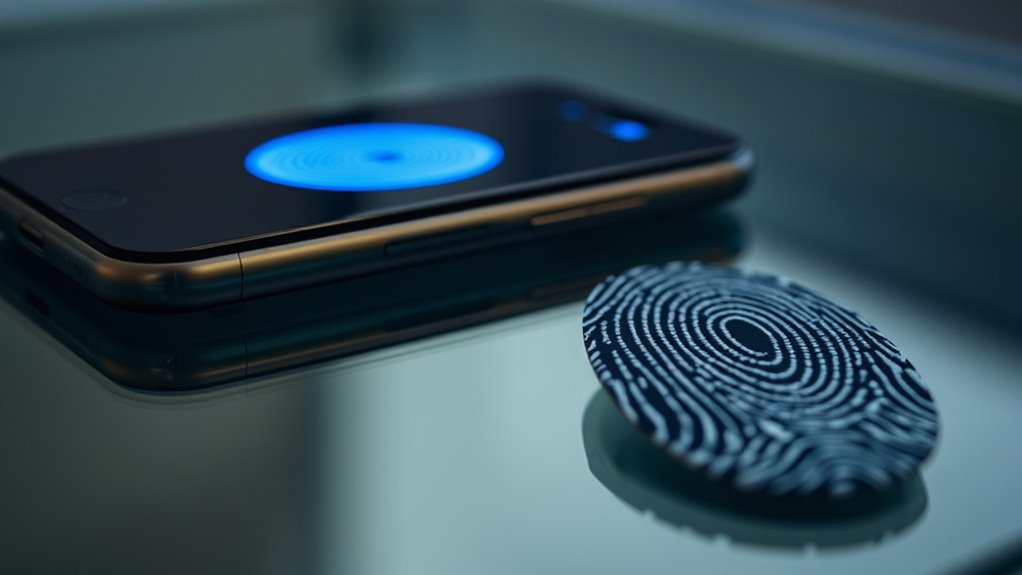Biometric passwords are generally safer than traditional ones because they rely on unique physical traits like fingerprints or facial features that are hard to steal or duplicate. However, they aren’t foolproof; vulnerabilities include spoofing, errors, and data breaches, which can expose sensitive info forever. Despite these concerns, ongoing innovations in encryption and spoof detection make them a better security choice. To understand the full picture, discover more about their advantages, risks, and future potential.
Key Takeaways
- Biometric passwords are harder to replicate than traditional passwords, offering enhanced security through unique physical traits.
- They are resistant to phishing since biometric data cannot be emailed or tricked like passwords.
- Vulnerabilities include spoofing with fake fingerprints or photos, risking unauthorized access.
- Data breaches of biometric databases can expose lifelong, unchangeable personal information.
- Combining biometrics with multi-factor authentication provides the highest security level.
Comparing Security Strengths of Biometric and Traditional Methods
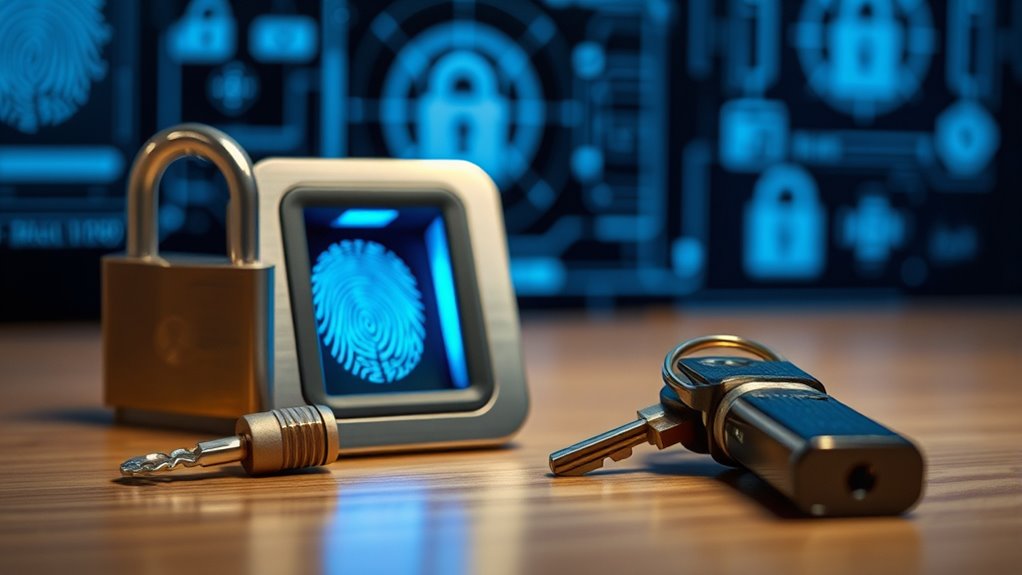
Biometric authentication offers several security advantages over traditional methods like passwords and PINs. Because your biometric data, such as fingerprints or facial features, are unique, they’re much harder for others to replicate or steal. Unlike passwords, biometrics are resistant to phishing, since physical traits can’t be tricked or sent via email. This means your security isn’t compromised by social engineering tactics. Additionally, biometrics provide faster access, making your experience smoother while maintaining high security. They’re also easier to use, eliminating the need to remember complex passwords. When integrated into multi-factor setups, biometrics enhance overall protection. These features make biometric systems a more robust and user-friendly alternative, profoundly elevating security compared to traditional password-based methods. Moreover, biometric systems can be integrated with ethical hacking practices to identify and fix potential vulnerabilities, ensuring ongoing security resilience. Furthermore, ongoing research into AI security helps improve biometric authentication methods by detecting and mitigating potential threats. Incorporating advanced algorithms further strengthens the reliability of biometric security systems against evolving cyber threats. Additionally, understanding personal data privacy concerns is vital to ensure that biometric information is securely stored and managed. Implementing secure data storage practices is essential to prevent breaches and unauthorized access to sensitive biometric information.
Common Vulnerabilities in Biometric Systems
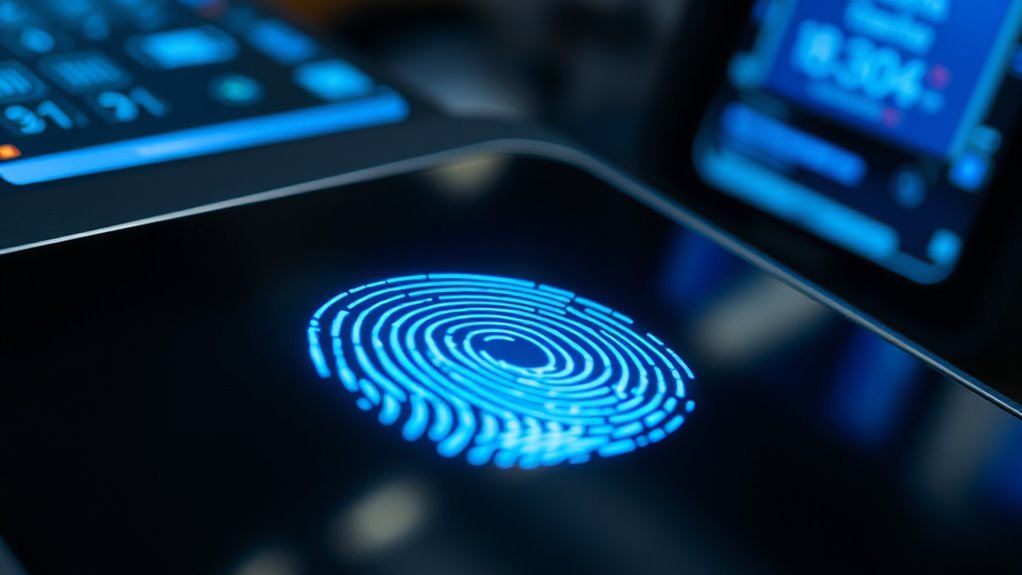
While biometric authentication offers significant security benefits, it’s important to recognize the vulnerabilities that can undermine its effectiveness. Inaccuracy and fraud risks pose serious concerns; false positives may grant unauthorized access, while false negatives can deny legitimate users. Attackers can exploit knowledge of specific biometric features through spoofing, using fake fingerprints, masks, or photos to bypass systems. Without robust anti-spoofing measures, facial recognition is especially vulnerable to replay attacks. Additionally, biometric data breaches are critical because, unlike passwords, biometric traits can’t be changed if stolen. Intercepted data can be reused in replay or relay attacks, especially if encryption and session protections are weak. Furthermore, biometric systems can be affected by environmental factors and poor lighting conditions, which can increase false negatives and reduce accuracy. This can lead to legitimate users being locked out and frustrated. It is also essential to implement secure data storage practices to prevent unauthorized access to biometric information. Finally, systems face threats from denial-of-service attacks and manipulation, which can disrupt access or compromise operational integrity. Moreover, biometric technology is constantly evolving, which can introduce new vulnerabilities that require ongoing security assessments.
Privacy and Ethical Concerns Surrounding Biometric Data
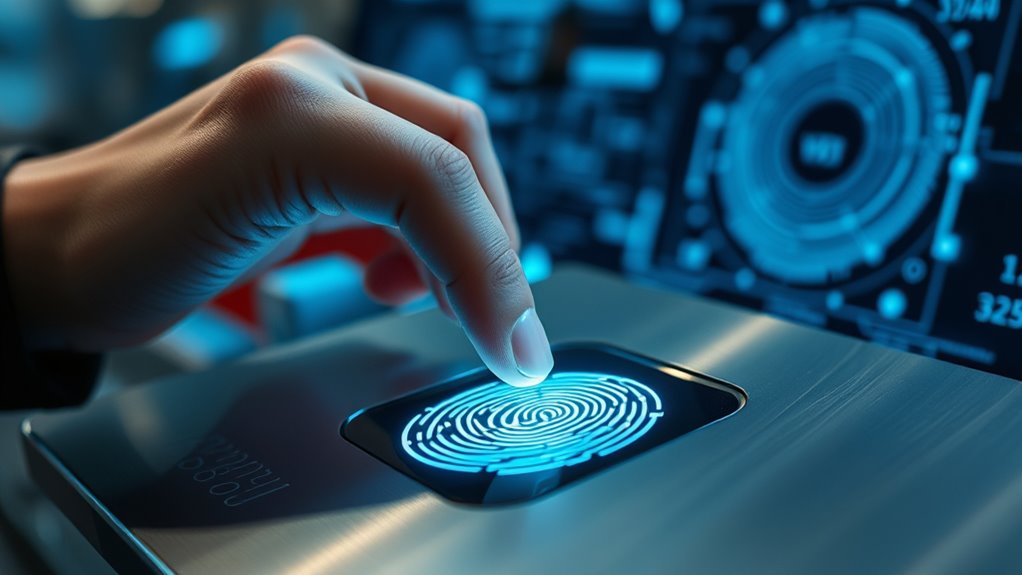
When organizations deploy biometric systems, they often overlook the significant privacy and ethical issues tied to collecting and storing sensitive personal data. Unlike passwords, biometric data can’t be reset or revoked if compromised, exposing you to lifelong risks like identity theft or impersonation. Breaches in biometric databases, such as government leaks, leave your data vulnerable indefinitely. These systems can covertly track your movements, revealing private activities like medical visits or religious practices, eroding your anonymity in public spaces. Facial recognition algorithms also show biases, with higher error rates for women and darker-skinned individuals, potentially reinforcing societal inequalities. furthermore, many users are unaware of how their data is stored or shared, and legal protections often lag behind, leaving your privacy and rights at risk.
Practical Challenges in Implementing Biometric Authentication
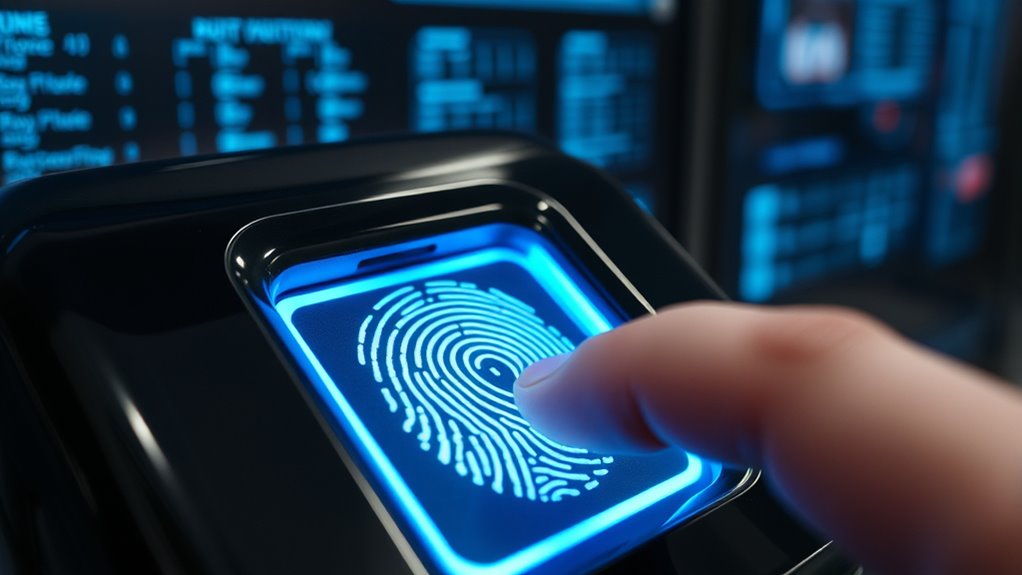
Implementing biometric authentication systems presents several practical challenges that can hinder their effectiveness and user acceptance. Technical limitations cause errors like false positives, false negatives, and enrollment failures due to poor sensor quality, environmental factors, or physical conditions. These issues can lead to unauthorized access or frustrate legitimate users, reducing system reliability. Enrollment can also be difficult for individuals with disabilities or medical conditions, limiting inclusivity. High costs for hardware, software, and infrastructure add financial hurdles, especially for smaller organizations. Additionally, the lack of universal standards causes incompatibilities between different systems, threatening security and interoperability. Environmental sensitivities and diversity considerations further complicate implementation, making it harder to create a seamless, accessible, and reliable biometric authentication experience. Proper sensor maintenance and calibration can mitigate some of these issues by ensuring consistent performance and accuracy, which is especially important given the cybersecurity vulnerabilities that can arise from system flaws. Moreover, technology standardization plays a critical role in enhancing compatibility and security across different biometric platforms. Recognizing the influence of biometric accuracy on overall security can help organizations prioritize investments in calibration and quality assurance processes.
Future Trends and Potential Risks in Biometric Security
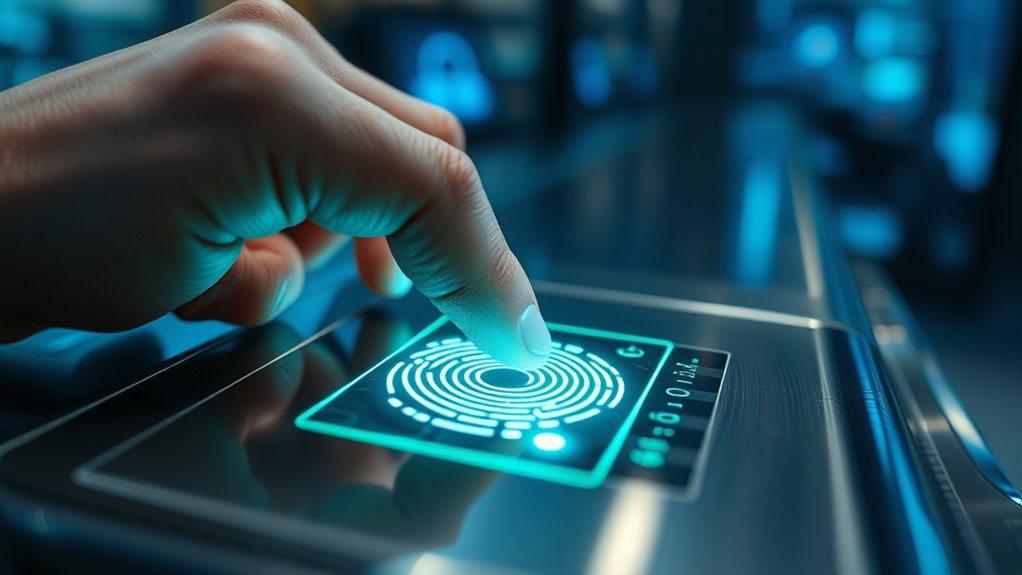
Future trends in biometric security point toward the widespread adoption of multimodal and contactless systems, which combine multiple biometric traits and enable hygienic, seamless authentication. You’ll see more integration of fingerprints, facial recognition, and voice in high-security settings, making access faster and more reliable. Contactless technologies like facial scans and palmprints will grow due to their hygiene benefits. As biometric data becomes essential for securing IoT devices, wearables, and financial transactions, advancements like AI-powered spoof detection and blockchain storage will enhance security. Additionally, ongoing research into biometric data encryption is vital to address potential vulnerabilities. Incorporating encryption solutions into biometric data management will be crucial to protect against unauthorized access and potential breaches. As these technologies evolve, establishing comprehensive privacy frameworks will be essential to maintain public trust and ensure ethical use. However, risks remain—privacy concerns, cyber threats, and sophisticated spoofing attempts pose challenges. Ensuring ethical use, regulatory compliance, and robust encryption will be indispensable as biometric systems evolve, aiming for safer, more efficient authentication methods. For example, biometric support hours in various sectors like entertainment and parks demonstrate the importance of reliable, accessible security systems in everyday life.
Frequently Asked Questions
How Do Biometric Systems Handle False Positives and Negatives?
Biometric systems manage false positives and negatives through advanced algorithms, improved sensor technology, and multi-factor authentication. When errors occur, they adjust matching thresholds, use liveness detection, and periodically re-enroll users to maintain accuracy. You can also reduce risks by ensuring good data quality, using diverse training datasets, and following best practices during enrollment. These efforts help balance security and user convenience while minimizing errors.
Can Biometric Data Be Permanently Compromised or Revoked?
You should know that once your biometric data is compromised, it can’t be revoked or changed like a password. Unlike passwords, biometrics are permanent and unique to you, so breaches pose lifelong risks. If someone steals your fingerprint or facial scan, they can reuse it endlessly, putting your identity at continuous threat. Protect your biometric information carefully, because unlike passwords, you can’t simply reset or cancel it after a breach.
What Legal Protections Exist for Biometric Data Privacy?
You should know that legal protections for biometric data privacy are strong and enforceable. Laws like Illinois BIPA and Massachusetts BIPA require informed consent, clear disclosures, and strict data retention and destruction policies. These laws also give you the right to seek damages if your biometric data is mishandled. Additionally, organizations must implement security measures to protect your data, making it harder for malicious actors to misuse your biometric information.
Are There Health Risks Associated With Biometric Scanning?
Health risks from biometric scanning are like shadows lurking unnoticed. You face potential contamination from touching shared surfaces, which can transfer germs and increase infection risks, especially in healthcare settings. Additionally, privacy breaches may lead to stress or anxiety, impacting your mental health. While physical harm is unlikely, system inaccuracies could cause delays or errors in critical moments. Staying aware and advocating for contactless options can help protect your health and well-being.
How Does Biometric Data Storage Impact Organizational Security Policies?
When considering how biometric data storage impacts your organization’s security policies, you realize the importance of strong encryption and secure storage practices. You need to implement regular audits, ensure compliance with privacy laws, and educate staff on handling sensitive data. Decentralized storage and data minimization reduce risks, while incident response plans prepare you for potential breaches. Ultimately, these measures help safeguard user privacy and bolster your organization’s overall security framework.
Conclusion
Ultimately, biometric passwords are like double-edged swords—offering sleek security but cutting deep with vulnerabilities. As you navigate this landscape, remember that relying solely on your fingerprint or face is like building a fortress on shifting sands. Stay informed, question the technology, and don’t forget that your privacy is the treasure at stake. In this high-tech game, you hold the key—guard it wisely before the digital storm sweeps it away.
